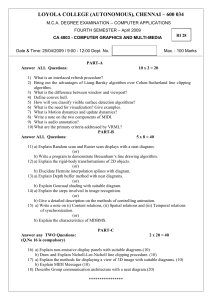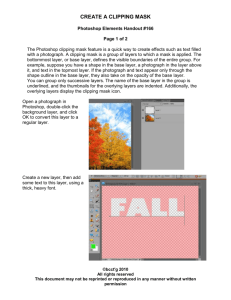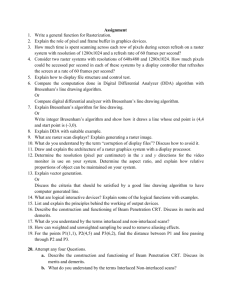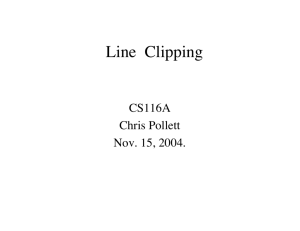tut4
advertisement
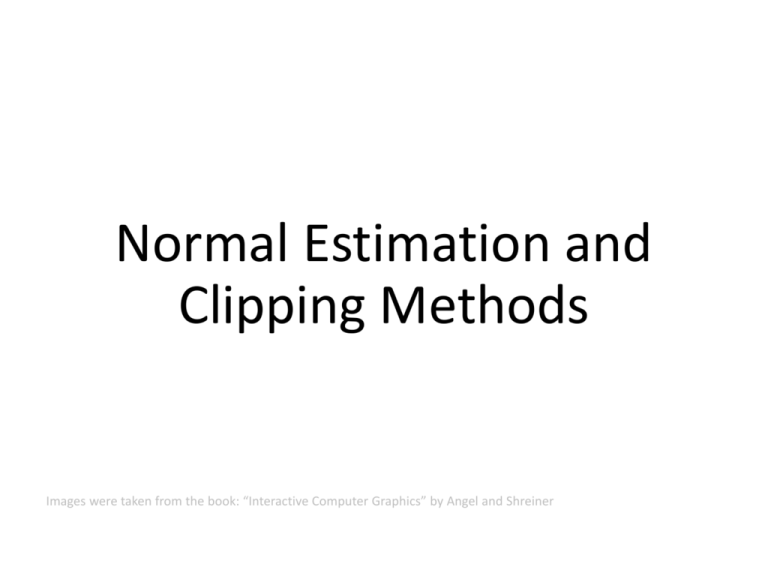
Normal Estimation and Clipping Methods Images were taken from the book: “Interactive Computer Graphics” by Angel and Shreiner Normal Vectors • How to compute the normal per planar face? 𝑛 𝑇 = 𝑥𝑗 − 𝑥𝑖 × 𝑥𝑘 − 𝑥𝑖 𝑥𝑗 − 𝑥𝑖 × (𝑥𝑘 − 𝑥𝑖 ) Normal Vectors • However, vertex normals are not well defined • Nevertheless, assume the shape is smooth 𝑛 𝑣 = 𝑇∈𝒩1 (𝑣) 𝜔 𝑇 𝑛 𝑇 𝑇∈𝒩1 (𝑣) 𝜔 𝑇 𝑛 𝑇 • How to choose 𝜔 𝑇 ? E.g., 𝜔 𝑇 = 1, 𝑇 , 𝜃𝑇 Normal Vectors • How to transform normal vectors? • Using the transformation matrix won’t work! Normal Vectors • How to transform normal vectors? • The following should hold 𝑛 ⋅ 𝑡 = 0 = 𝐺𝑛 ⋅ 𝑀𝑡 • Thus, 𝐺 T 𝑀 = I ⇒ 𝐺 = 𝑀−1 T Clipping • When and how to perform clipping? • Wireframe rendering: – Clipping can be done in screen coordinates – Cull/Draw the triangle if it is outside/inside – Border triangles: • Line-Segment clipping or • Ignore pixels Line-Segment Clipping • Given two endpoints 𝑥1 , 𝑦1 T and 𝑥2 , 𝑦2 • Line segment in parametric form: 𝛼 ∈ 0,1 𝑥 𝛼 = 1 − 𝛼 𝑥1 + 𝛼𝑥2 , 𝑦 𝛼 = 1 − 𝛼 𝑦1 + 𝛼𝑦2 . T 𝑥 𝛼 = 1 − 𝛼 𝑥1 + 𝛼𝑥2 , 𝑦 𝛼 = 1 − 𝛼 𝑦1 + 𝛼𝑦2 . Line-Segment Clipping • Liang–Barsky [TOG ‘84] Clipping • Defer computation of line intersection asmuch-as-possible 𝑥 𝛼 = 𝑥1 + 𝛼(𝑥2 − 𝑥1 ), 𝑦 𝛼 = 𝑦1 + 𝛼(𝑦2 − 𝑦1 ). Liang–Barsky Clipping • A point is in the clip window if 𝑥min ≤ 𝑥1 + 𝛼Δ𝑥 ≤ 𝑥max , 𝑦min ≤ 𝑦1 + 𝛼Δ𝑦 ≤ 𝑦max . 𝑥 𝛼 = 𝑥1 + 𝛼(𝑥2 − 𝑥1 ), 𝑦 𝛼 = 𝑦1 + 𝛼(𝑦2 − 𝑦1 ). Liang–Barsky Clipping • A point is in the clip window if 𝛼𝑝𝑘 ≤ 𝑞𝑘 , 𝑘 = 1,2,3,4 • Where 𝑝1 = −Δ𝑥, 𝑝2 = Δ𝑥, 𝑝3 = −Δ𝑦, 𝑝4 = Δ𝑦, 𝑞1 = 𝑥1 − 𝑥min 𝑞2 = 𝑥max − 𝑥1 𝑞3 = 𝑦1 − 𝑦min 𝑞4 = 𝑦max − y1 left right bottom top 𝛼𝑝𝑘 ≤ 𝑞𝑘 Liang–Barsky Clipping • Determine the final line segment – Find 𝑘 for which 𝑝𝑘 < 0, then 𝛼1 = max 𝑞𝑘 0, 𝑝𝑘 . – Find 𝑘 for which 𝑝𝑘 > 0, then 𝛼2 = min 𝑞𝑘 1, 𝑝𝑘 . – Similarly for 𝛼3 and 𝛼4 Polygon Clipping • Follows directly from line-clipping • Apply clipping to the edges of the polygon • Clipping a convex polygon against a convex polygon results in at most one convex object Polygon Clipping • We can implement a clipping pipeline • Each clipper clips against one window’s edge Polygon Clipping • Example of pipeline clipping Clipping • When and how to perform clipping? • Scan Conversion – Perform clipping before perspective division – The visible volume 𝑤 ≥ 𝑥 ≥ −𝑤, 𝑤 ≥ 𝑦 ≥ −𝑤, 𝑤 ≥ 𝑧 ≥ −𝑤. Clipping • For each model – Determine if it is inside/outside the view volume • Intersect its bounding box with the view volume – For each boundary model • Perform polygon-clipping for each triangle • Thus, extend our clipping to three dimensions Bounding Box • How to compute the bounding box? • Find the minimal/maximal coordinates 3D Polygon Clipping • Extend Liang–Barsky with the equation 𝑧 𝛼 = 1 − 𝛼 𝑧1 + 𝛼𝑧2 • Add near and far clippers in the pipeline • Need to adjust intersection computations… 3D Polygon Clipping • Plane–Line intersection is given by 𝑛 ⋅ 𝑝0 − 𝑝1 𝛼= 𝑛 ⋅ 𝑝2 − 𝑝1 Suggested Readings • Transforming Normals: – http://www.lighthouse3d.com/tutorials/glsl-tutorial/the-normal-matrix/ – http://www.unknownroad.com/rtfm/graphics/rt_normals.html • Interactive Computer Graphics, Chapter 6 • Liang–Barsky Clipping: – http://en.wikipedia.org/wiki/Liang%E2%80%93Barsky_algorithm




